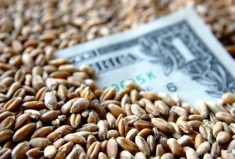Chicago | Reuters — U.S. soybean and corn futures each fell more than one per cent on Friday as clearing skies in the Midwest signaled a quicker pace in the harvest of record-large crops and increased farmer selling, traders said.
Wheat closed modestly lower, retreating from a one-month high on profit-taking and spillover weakness from corn and soy.
At the Chicago Board of Trade, November soybeans settled down 14-3/4 cents at $9.51-3/4 per bushel (all figures US$). December corn ended down 4-1/4 cents at $3.48 a bushel, and December wheat fell one cent to $5.16 a bushel.
Read Also

U.S. grains: Soybeans bounce as Chinese demand assessed, wheat drops
Chicago soybean prices firmed on Friday in a bargain-buying bounce after a sharp fall on Thursday, as traders assessed prospects for more U.S. sales to China after the trade war truce between the countries.
Forecasts called for mostly dry conditions across the Midwest for the next 10 days. The sunshine should dry saturated fields after a week-long rainy spell that hit the southern half of the Corn Belt especially hard.
The U.S. Department of Agriculture said the U.S. corn harvest was only 24 per cent complete by Oct. 12, compared with the five-year average of 43 per cent. Soybeans were 40 per cent harvested, compared with the average of 53 per cent. Traders expect farmers to make up for lost time in the coming days.
“Monday’s Crop Progress Report is expected to show the bean harvest above 50 per cent complete and the corn harvest above 30 per cent complete. Good harvesting weather is expected to increase the pace of harvest, and pressure storage and transportation availability,” KCG Futures vice-president Helen Pound wrote in a daily note.
Soybeans came under additional pressure after private analytics firm Informa Economics raised its projection of U.S. soybean plantings for 2015 to a record-high 88.5 million acres. If realized, the 2015 figures would represent the first time since 1983 that U.S. farmers plant more soybeans than corn.
Despite Friday’s lower closes, corn, soybeans and wheat all posted weekly gains, with front-month corn rising 4.2 per cent, its biggest weekly jump since March.
The gains reflected recent harvest delays that slowed the flow of grain into marketing channels, along with short-covering by funds. Also supportive was a setback in the U.S. dollar from four-year highs. A softer dollar makes dollar-denominated grains more attractive to those holding other currencies.
Some analysts suggested grains could benefit from a shift in funds from struggling equity markets, while others said there could be spillover weakness from oil.
“Grain prices have been recovering since the beginning of the month but the supply/demand balance remains tilted towards plentiful supply,” Deutsche Bank said in a note.
CBOT wheat turned lower after the December contract reached its highest level in more than a month. The contract encountered chart-based resistance above its 50-day moving average of $5.19-1/2.
— Julie Ingwersen is a Reuters correspondent covering grain markets from Chicago. Additional reporting for Reuters by Nigel Hunt in London and Naveen Thukral in Singapore.














